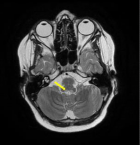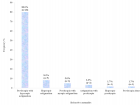Abstract
Case Report
Celiac disease in a teenager revealed with Wernicke Encephalopathy
Amira Bouayad*, Chaimae Khodriss, Sihame Tantani, Hicham Fadel, Siham Alaoui Rachidi and Meriem Elbahloul
Published: 27 December, 2023 | Volume 7 - Issue 2 | Pages: 011-014
Background: Wernicke encephalopathy is an acute neurological condition defined by a clinical triad of ophthalmoplegia, ataxia, and confusion. This disease is due to thiamine deficiency.
Case presentation: After persistent diarrhea and vomiting, a 15-year-old boy presented up-beating nystagmus, with binocular vertical diplopia and unstable gait. An etiological workup revealed a celiac disease. Magnetic resonance imaging showed bilateral periaqueductal region lesions.
Treatment and discussion: Because of suspected Wernicke’s encephalopathy, the patient was treated with thiamine replacement and significant improvement of symptoms took place. Wernicke encephalopathy is a serious medical disorder with enormous morbidity and mortality. Evaluation should include patient history with a physical and ophthalmologic examination and laboratory workup with appropriate imaging.
Conclusion: Undiagnosed celiac disease can lead to malabsorption of vitamin B1 causing acute symptoms of Wernicke encephalopathy.
Read Full Article HTML DOI: 10.29328/journal.ijceo.1001054 Cite this Article Read Full Article PDF
Keywords:
Nystagmus; Bilateral sixth nerve palsy; Celiac disease; Thiamine wernicke’s encephalopathy
References
- Theodoreson MD, Zykaite A, Haley M, Meena S. Case of non-alcoholic Wernicke's encephalopathy. BMJ Case Rep. 2019 Nov 14;12(11):e230763. doi: 10.1136/bcr-2019-230763. PMID: 31732541; PMCID: PMC6887470.
- Ota Y, Capizzano AA, Moritani T, Naganawa S, Kurokawa R, Srinivasan A. Comprehensive review of Wernicke encephalopathy: pathophysiology, clinical symptoms and imaging findings. Jpn J Radiol. 2020 Sep;38(9):809-820. doi: 10.1007/s11604-020-00989-3. Epub 2020 May 10. PMID: 32390125.
- Lebwohl B, Rubio-Tapia A. Epidemiology, Presentation, and Diagnosis of Celiac Disease. Gastroenterology. 2021 Jan;160(1):63-75. doi: 10.1053/j.gastro.2020.06.098. Epub 2020 Sep 18. PMID: 32950520.
- Liang H, Wu L, Liu LL, Han J, Zhu J, Jin T. A case report: Non-alcoholic Wernicke encephalopathy associated with polyneuropathy. J Int Med Res. 2017 Dec;45(6):1794-1801. doi: 10.1177/0300060517699039. Epub 2017 Apr 3. PMID: 28367669; PMCID: PMC5805199.
- Hokazono K, Geminiani F, Bertholdo D. Acute up-beating nystagmus in a pregnant woman with hyperemesis gravidarum. Am J Ophthalmol Case Rep. 2017 Mar 14;6:81-83. doi: 10.1016/j.ajoc.2017.01.008. PMID: 29260066; PMCID: PMC5722145.
- Fujikawa T, Sogabe Y. Wernicke encephalopathy. CMAJ. 2020 Feb 10;192(6):E143. doi: 10.1503/cmaj.190998. PMID: 32041699; PMCID: PMC7012630.
- Ong C, Patel K, Musiek E, Van Stavern G. Mystery case: a young woman with isolated upbeating nystagmus. Neurology. 2015 Jan 27;84(4):e17-9. doi: 10.1212/WNL.0000000000001178. PMID: 25628435.
Figures:

Figure 1

Figure 2

Figure 3

Figure 4

Figure 5
Similar Articles
-
Celiac disease in a teenager revealed with Wernicke EncephalopathyAmira Bouayad*, Chaimae Khodriss, Sihame Tantani, Hicham Fadel, Siham Alaoui Rachidi, Meriem Elbahloul. Celiac disease in a teenager revealed with Wernicke Encephalopathy. . 2023 doi: 10.29328/journal.ijceo.1001054; 7: 011-014
Recently Viewed
-
The Role of Diet Therapy in Reducing the Cardiovascular Disease Risk in a Patient with a Long-Standing and Recurring History of ObesityRangelova L*, Nikolova M. The Role of Diet Therapy in Reducing the Cardiovascular Disease Risk in a Patient with a Long-Standing and Recurring History of Obesity. J Community Med Health Solut. 2024: doi: 10.29328/journal.jcmhs.1001050; 5: 069-071
-
A Study of Doppler velocimetry in pre-eclampsia patients, and their perinatal outcomeRahul Khatri*,Bhoomika Jain,Sabrina Mhapankar,Sushil Kumar. A Study of Doppler velocimetry in pre-eclampsia patients, and their perinatal outcome. Clin J Obstet Gynecol. 2021: doi: 10.29328/journal.cjog.1001085; 4: 044-049
-
Neurovascular Shifts, Sensory Sensitivity, and PMDD in Autistic Women: Exploring Blood Flow Redirection, Mood Dysregulation, and Pain Tolerance during MenstruationPiper Hutson, James Hutson*. Neurovascular Shifts, Sensory Sensitivity, and PMDD in Autistic Women: Exploring Blood Flow Redirection, Mood Dysregulation, and Pain Tolerance during Menstruation. J Community Med Health Solut. 2024: doi: 10.29328/journal.jcmhs.1001049; 5: 062-068
-
Comparative study of continuous method and interrupted method of episiotomy in terms of healing of the surgical woundRahul Khatri*,Bhoomika Jain,Sabrina Mhapankar,Sushil Kumar. Comparative study of continuous method and interrupted method of episiotomy in terms of healing of the surgical wound. Clin J Obstet Gynecol. 2021: doi: 10.29328/journal.cjog.1001084; 4: 040-043
-
Prevalence of Risk factors of Non Communicable Diseases amongst Medical Students, Kanpur, Uttar Pradesh, IndiaLakshmi Singh*, Anju Gahlot, Atul Kumar Singh. Prevalence of Risk factors of Non Communicable Diseases amongst Medical Students, Kanpur, Uttar Pradesh, India. J Community Med Health Solut. 2024: doi: 10.29328/journal.jcmhs.1001048; 5: 057-061
Most Viewed
-
Evaluation of Biostimulants Based on Recovered Protein Hydrolysates from Animal By-products as Plant Growth EnhancersH Pérez-Aguilar*, M Lacruz-Asaro, F Arán-Ais. Evaluation of Biostimulants Based on Recovered Protein Hydrolysates from Animal By-products as Plant Growth Enhancers. J Plant Sci Phytopathol. 2023 doi: 10.29328/journal.jpsp.1001104; 7: 042-047
-
Sinonasal Myxoma Extending into the Orbit in a 4-Year Old: A Case PresentationJulian A Purrinos*, Ramzi Younis. Sinonasal Myxoma Extending into the Orbit in a 4-Year Old: A Case Presentation. Arch Case Rep. 2024 doi: 10.29328/journal.acr.1001099; 8: 075-077
-
Feasibility study of magnetic sensing for detecting single-neuron action potentialsDenis Tonini,Kai Wu,Renata Saha,Jian-Ping Wang*. Feasibility study of magnetic sensing for detecting single-neuron action potentials. Ann Biomed Sci Eng. 2022 doi: 10.29328/journal.abse.1001018; 6: 019-029
-
Pediatric Dysgerminoma: Unveiling a Rare Ovarian TumorFaten Limaiem*, Khalil Saffar, Ahmed Halouani. Pediatric Dysgerminoma: Unveiling a Rare Ovarian Tumor. Arch Case Rep. 2024 doi: 10.29328/journal.acr.1001087; 8: 010-013
-
Physical activity can change the physiological and psychological circumstances during COVID-19 pandemic: A narrative reviewKhashayar Maroufi*. Physical activity can change the physiological and psychological circumstances during COVID-19 pandemic: A narrative review. J Sports Med Ther. 2021 doi: 10.29328/journal.jsmt.1001051; 6: 001-007

HSPI: We're glad you're here. Please click "create a new Query" if you are a new visitor to our website and need further information from us.
If you are already a member of our network and need to keep track of any developments regarding a question you have already submitted, click "take me to my Query."















































































































































